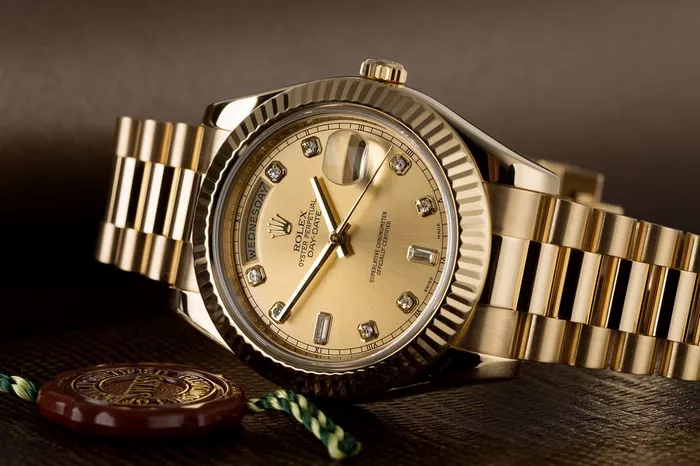Rolex watches often come with nicknames that can be as enigmatic as they are memorable. These monikers, though they may seem whimsical or obscure, have become integral to the lexicon of watch enthusiasts. Here’s a guide to understanding the nicknames of 15 iconic Rolex models, shedding light on their origins and significance.
The Kermit
Introduced in 2003, the Rolex Submariner reference 16610LV, known as the “Kermit,” was launched to mark the 50th anniversary of the Submariner. This model featured a distinctive green bezel, a first for the series, paired with a black “maxi dial.” The playful nickname, inspired by the green Muppet, has since become synonymous with this sought-after watch, which now commands prices exceeding $15,000 for well-preserved examples with original packaging and documentation.
The Hulk
A direct evolution of the Kermit, the Rolex Submariner reference 116610LV, nicknamed the “Hulk,” was released in 2010. This model boasted a more robust case and an even more vibrant green dial and bezel. The term “Hulk” reflects its larger, bolder presence compared to its predecessors. The “super case” and vibrant green color make this model a standout in Rolex’s lineup.
The Pepsi
The Rolex GMT-Master II with a blue and red bezel is widely recognized as the “Pepsi.” First introduced in 1954, this color scheme was designed to differentiate between day and night hours. The nickname “Pepsi” was adopted due to the bezel’s resemblance to the iconic cola brand’s color palette, making it a staple name in the world of Rolex watches.
The Coke
Following the Pepsi, the “Coke” nickname refers to Rolex GMT-Master II models with a black and red bezel. While not directly linked to the Coca-Cola brand, the color scheme evokes imagery of the classic soft drink’s red label, lending the watch its distinctive name.
The Root Beer
The “Root Beer” designation applies to various Rolex GMT-Master II watches featuring brown bezels. The term, though reminiscent of the popular A&W beverage, broadly refers to any model with a brown color scheme. This nickname also occasionally extends to models with brown dials, such as the reference 16753, which has been dubbed “Clint Eastwood” or “Dirty Harry” due to the actor’s association with the watch.
The Batman
The Rolex GMT-Master II reference with a black and blue bezel is known as the “Batman.” This nickname deviates from the soda theme, drawing instead from the superhero’s color scheme. The name reflects the dark and vibrant tones of the bezel, which are reminiscent of the iconic superhero’s costume.
The Bluesy
The “Bluesy” nickname refers to the Rolex Submariner with a blue dial and bezel. Introduced in 1985, this two-tone model—combining steel and gold—stands out for its striking blue color. Rolex’s own term for this combination is “Rolesor,” but the affectionate nickname “Bluesy” has endured among collectors.
The John Player Special
The Rolex Daytona reference 6241 with a black Paul Newman dial and distinctive seconds markers is known as the “John Player Special.” This nickname pays homage to the black and gold livery of John Player Special cigarettes, reflecting the watch’s bold color scheme and its association with the famous brand.
The Jean-Claude Killy
Named after the legendary skier and Rolex ambassador, the “Jean-Claude Killy” encompasses five references of the Dato-Compax, including the 4768, 4767, 5036, 6036, and 6236. Despite Killy never being photographed with this model, it is named in his honor due to his connection with Rolex and the watch’s rare and complex design.
The Paul Newman
The “Paul Newman” nickname is applied to Rolex Daytonas with exotic dials, characterized by unique art deco numerals. This name originated from a photograph of Paul Newman wearing his personal Daytona, which popularized the reference among collectors. The nickname endures despite the model spanning several references.
The Snowflake
Although this model is from Tudor rather than Rolex, the “Snowflake” deserves mention. The Tudor Submariner reference 7016/0, introduced in 1969, features snowflake-shaped hands and square indices. This distinctive design was requested by the French Marine Nationale for improved underwater visibility.
The Mil-Sub
The “Mil-Sub” refers to Rolex Submariner models issued to the British Ministry of Defence, including references 5513, 5517, and the double-reference 5513/5517. Produced between 1971 and 1979, these watches were issued to SBS and SAS operators and are notable for their fully graduated bezels and circle “T” dials.
The Pre-Daytona
The Rolex reference 6239, introduced in 1963, is often referred to as the “Pre-Daytona.” This model, which features a smooth bezel and tachymeter scale printed on the dial, represents the precursor to the iconic Daytona series and exhibits the early design elements of what would become the Daytona.
The Padellone
The “Padellone,” or “large frying pan,” is one of two vintage Rolex models with a triple-date complication and moon phase, the other being the Oyster-cased 6062. Produced in the 1950s, this model’s oversized 38mm case earned it its Italian nickname and remains a highly sought-after collector’s item.
The Stelline
Finally, the Rolex reference 6062, dating back to the early 1950s, is known as the “Stelline,” or “starlet.” This model features a triple-date complication with moon phase and was produced with star-shaped indices on certain dials. The Stelline is exceptionally rare and highly prized among collectors.
These nicknames, while sometimes whimsical, provide a fascinating glimpse into the rich tapestry of Rolex’s history and the unique ways in which collectors and enthusiasts connect with these legendary timepieces.

